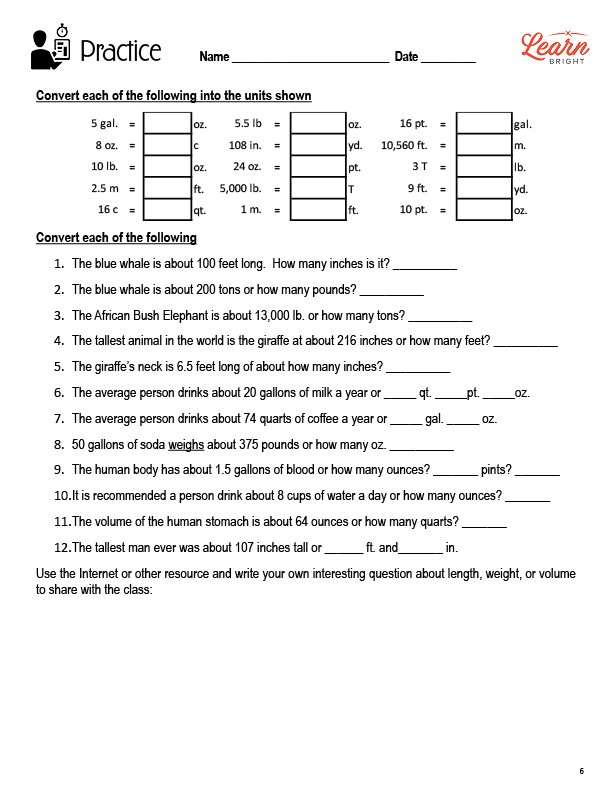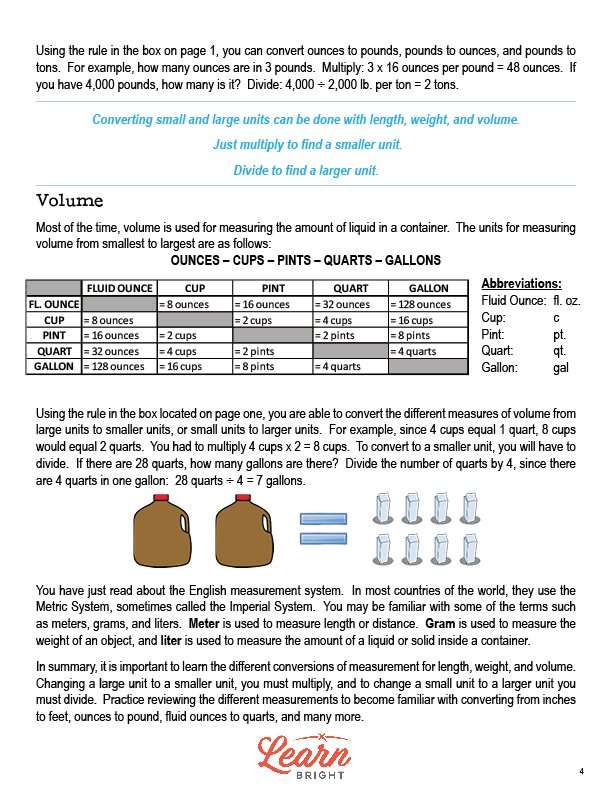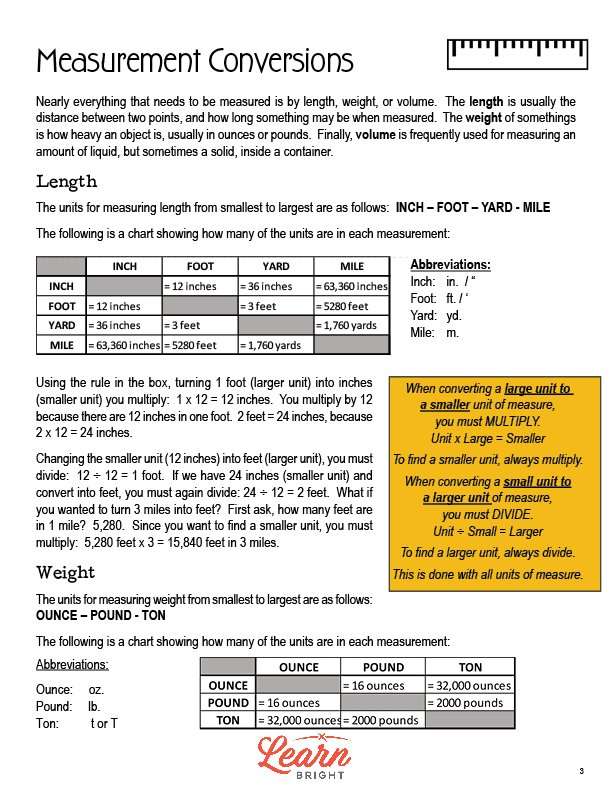Description
What our Measurement Conversions lesson plan includes
Lesson Objectives and Overview: Measurement Conversions teaches students the basics of converting from one unit of measurement to another. At the end of the lesson, students will be able to identify customary measurements for length, weight, and volume. The students will also be able to convert the measurements for length, weight, and volume. This lesson is for students in 4th grade, 5th grade, and 6th grade.
Classroom Procedure
Every lesson plan provides you with a classroom procedure page that outlines a step-by-step guide to follow. You do not have to follow the guide exactly. The guide helps you organize the lesson and details when to hand out worksheets. It also lists information in the blue box that you might find useful. You will find the lesson objectives, state standards, and number of class sessions the lesson should take to complete in this area. In addition, it describes the supplies you will need as well as what and how you need to prepare beforehand.
Options for Lesson
Included with this lesson is an “Options for Lesson” section that lists a number of suggestions for activities to add to the lesson or substitutions for the ones already in the lesson. One optional addition to the lesson activity is to take your students outdoors to measure longer lengths. For the activity, you can have your students use the measuring cup and turn the 16-ounce bottle into a measuring “bottle” using a permanent marker to show ounces on the side of the bottle. Finally, for an additional activity, you could assign each student a unit of measure to research, finding the origin of the word and more.
Teacher Notes
The teacher notes page includes a paragraph with additional guidelines and things to think about as you begin to plan your lesson. This page also includes lines that you can use to add your own notes as you’re preparing for this lesson.
MEASUREMENT CONVERSIONS LESSON PLAN CONTENT PAGES
Measurement Conversions
The Measurement Conversions lesson plan includes two content pages. Almost everything can be measured by length, weight, or volume. Length is the distance between two points and is how long something is when measured. Weight is how heavy an object is and is usually measured in ounces or pounds. Finally, volume measures the amount of liquid (or a solid) inside a container.
Length
We measure length using the units inches, feet, yards, and miles. The lesson includes a helpful chart that shows how to convert between these units. A foot is 12 inches, a yard is 36 inches, and a mile is 63,360 inches. A yard is 3 feet and a mile is 5,280 feet. And finally, a mile is 1,760 yards. We abbreviate inch to in., foot to ft., yard to yd., and mile to m.
To convert a larger unit into a smaller unit, we multiply. Using the provided conversions, we know that to convert 1 foot into inches, we multiply 1 x 12 = 12 inches. We multiply by 12 because there are 12 inches in a foot. To convert 2 feet into inches, we multiply 2 x 12 = 24. 2 feet equals 24 inches.
To convert a smaller unit into a larger unit, we divide. To convert 12 inches into feet, we divide 12 ÷ 12 = 1 foot. And to convert 24 inches into feet, we divide 24 ÷ 12 = 2 feet.
To convert 3 miles into feet, we multiply since we’re converting a larger unit into a smaller unit: 5,280 x 3 = 15,840 feet in 3 miles.
Weight
We measure weight using the units ounces, pounds, and tons. The lesson includes a helpful chart that shows how to convert between these units. A pound is 16 ounces. A ton is 32,000 ounces or 2,000 pounds. We abbreviate ounce to oz., pound to lb., and ton to t or T.
Like with length, to convert a larger unit into a smaller unit, we multiply. To convert a smaller unit into a larger unit, we divide. Following this rule, to figure out how many ounces are in 3 pounds, we multiply: 3 x 16 ounces per pound = 48 ounces. To figure out how many tons are in 2,000 pounds, we divide: 4,000 ÷ 2,000 lb. per ton = 2 tons.
Volume
Most of the time, when we’re measuring volume, we’re finding the amount of liquid in a container. We measure volume using the units fluid ounces, cups, pints, quarts, and gallons. The lesson includes a helpful chart that shows how to convert between these units.
A cup is 8 fluid ounces, a pint is 16 fluid ounces, a quart is 32 fluid ounces, and a gallon is 128 fluid ounces. A pint is 2 cups, a quart is 4 cups, and a gallon is 16 cups. A quart is 2 pints and a gallon is 8 pints. Finally, a gallon is 4 quarts. We abbreviate fluid ounce to fl. oz., cup to c., pint to pt., quart to qt., and gallon to gal.
Like length and weight, to convert a larger unit into a smaller unit, we multiply. To convert a smaller unit into a larger unit, we divide. For example, to figure out how many cups are in two quarts, we multiply 4 cups x 2 = 8 cups. To figure out how many gallons there are in 28 quarts, we divide the number of quarts by 4, since there are 4 quarts in one gallon: 28 quarts ÷ 4 = 7 gallons.
The Metric System
In most parts of the world, outside of the United States, they use a different system of measurement called the Metric System (or the Imperial System). Some of the units used in the Metric System include meters (length), grams (weight), and liters (volume).
It’s very important to learn how to convert between different units of measurement for length, width, and volume. Always remember that, when converting a large unit to a smaller unit, you multiply; and when converting a small unit to a larger unit, you divide. The more you practice, the easier it will be!
MEASUREMENT CONVERSIONS LESSON PLAN WORKSHEETS
The Measurement Conversions lesson plan includes three worksheets: an activity worksheet, a practice worksheet, and a homework assignment. You can refer to the guide on the classroom procedure page to determine when to hand out each worksheet.
MEASURING ACTIVITY WORKSHEET
Students will work with a partner to complete the lesson activity. Each pair receives a ruler, a food package, a 16-ounce bottle, a measuring cup, and two empty containers. They will use these supplies to measure various things around the classroom, like the length of a wall and the volume of the water bottle. They will record their findings on the worksheet.
CONVERSION PRACTICE WORKSHEET
The practice worksheet asks students to convert between different units.
MEASUREMENT CONVERSIONS HOMEWORK ASSIGNMENT
For the homework assignment, students will try to answer 20 questions about measurement conversions without using the lesson material for help, to test their knowledge. They will then write down the abbreviations for different units of measurement.
Worksheet Answer Keys
This lesson plan includes answer keys for the practice worksheet and the homework assignment. If you choose to administer the lesson pages to your students via PDF, you will need to save a new file that omits these pages. Otherwise, you can simply print out the applicable pages and keep these as reference for yourself when grading assignments.









